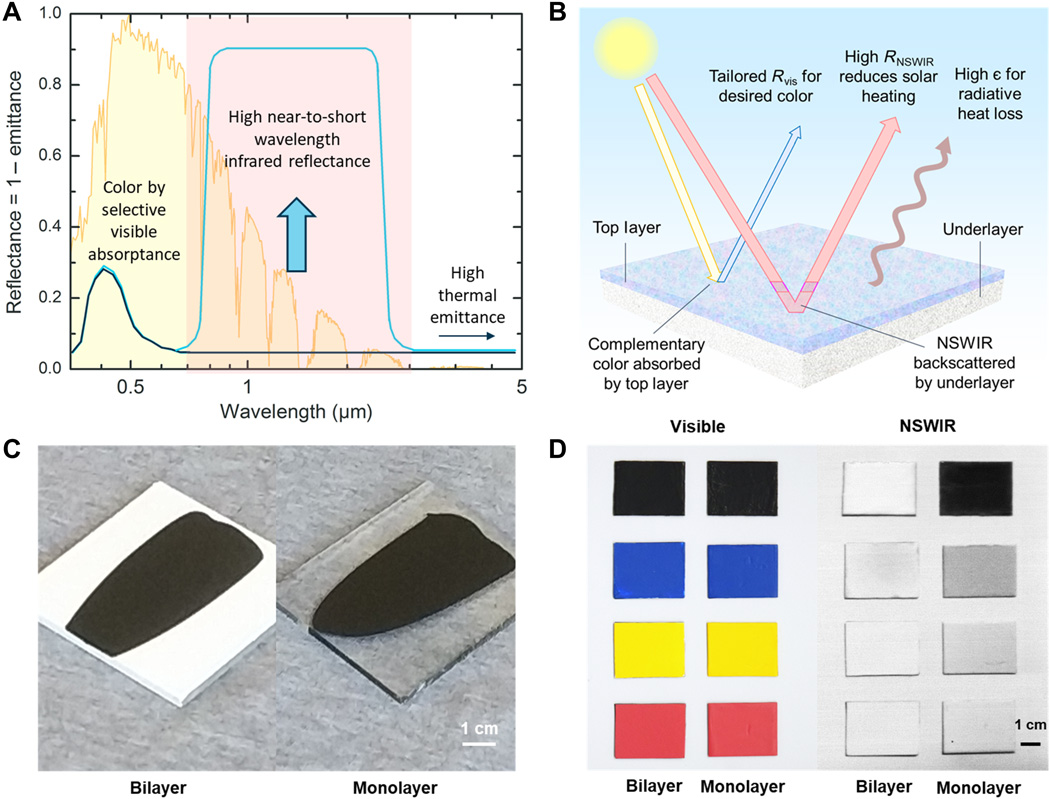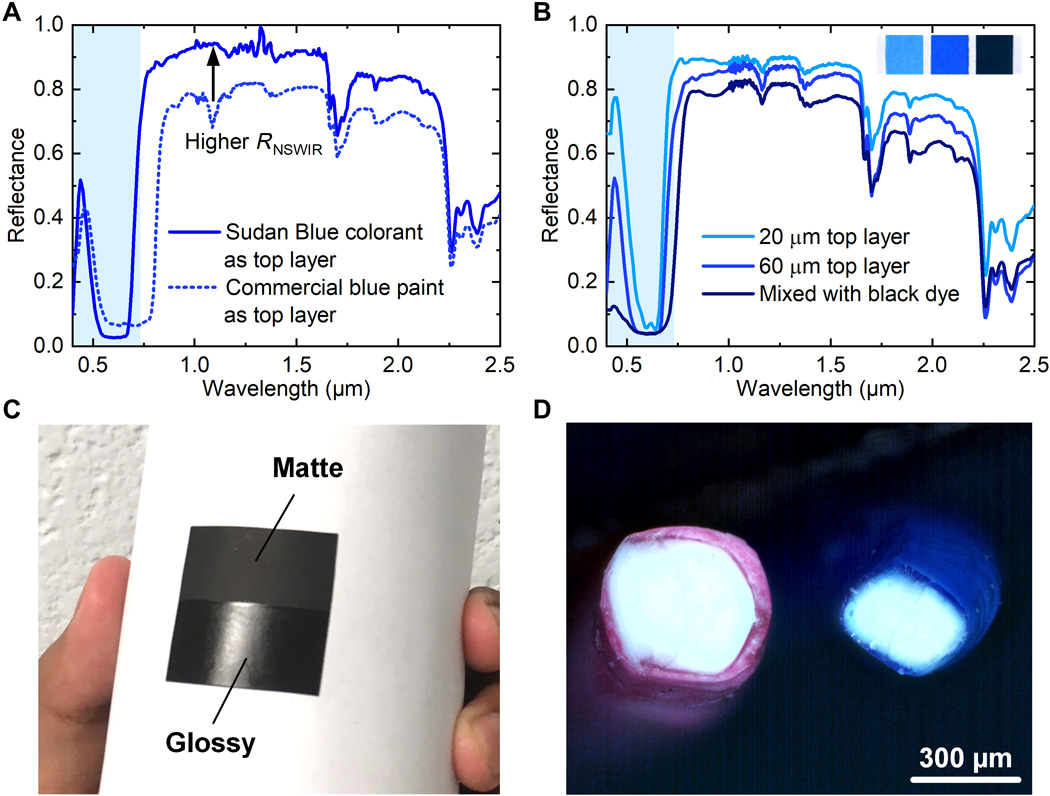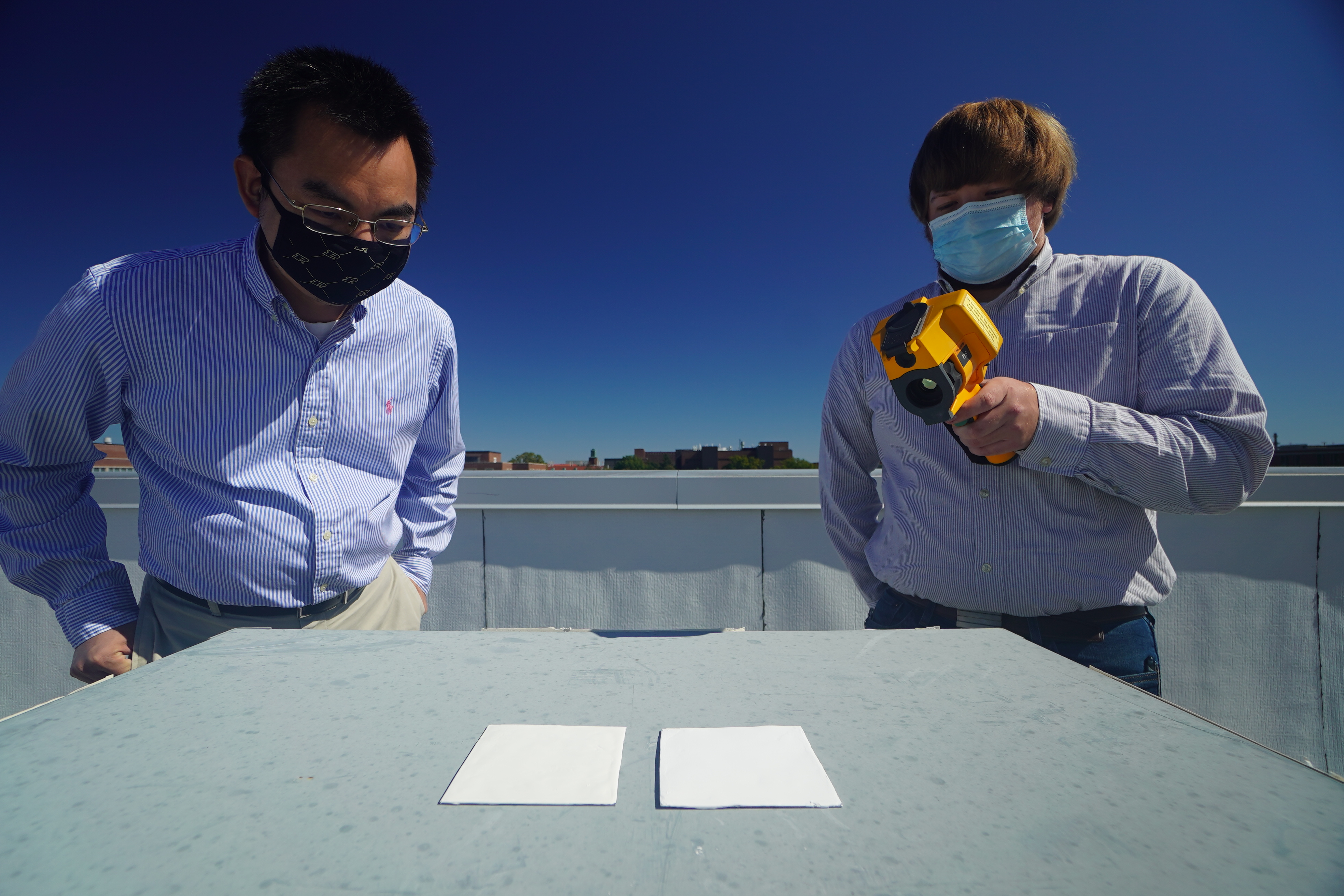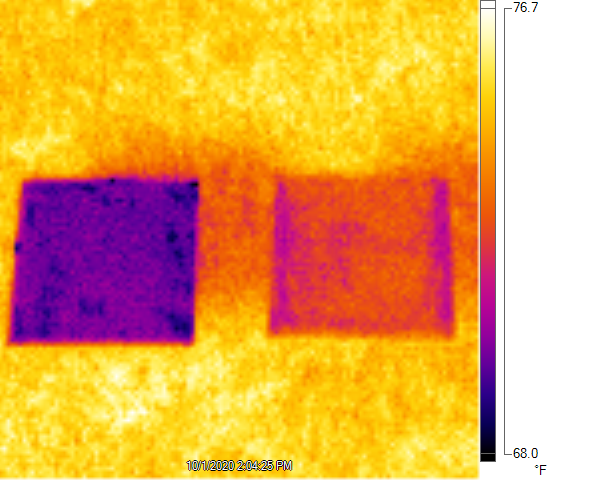Cool paint

|
|
Bilayer coloured radiative coolers (CRCs) for enhanced near-to-short wavelength infrared reflectance (NSWIR).
Photo credits: Photograph C - J.M., Columbia University; Photograph D - S.S., Columbia University. |
Contents |
[edit] Introduction
Paint is a liquid material that can be applied to surfaces to colour, protect and provide texture. In 2020, researchers announced the development of two types of innovative reflective paints that can also serve to cool surfaces and help to reduce energy consumption in buildings.
[edit] Coloured reflective coating
In April 2020, a group of scientists at New York’s Columbia University, under the guidance of Yuan Yang, introduced a bilayer, multicoloured infrared reflective paint. The top layer of this coating is made up of commercial, coloured paint while the bottom layer incorporates an infrared reflective polymer. Regardless of the colour selected for the top layer, the coating maintains its reflective properties.
Historically, paints containing titanium dioxide (TiO2) and colourants tend to absorb near-to-short wavelength infrared reflectance (NSWIR) wavelengths. This usually makes them hotter rather than cooler when exposed to sunlight. However, Yang’s top layer coating selectively absorbs visible wavelengths that are complementary to the desired colour but not others, while the underlayer maximises the distribution of any sunlight transmitted by the top layer.
Consequently, the two layers exhibit similar colours and visible reflectances (RVIS) to those of commercial monolayer paint - but with improved NSWIR. This results in a higher cooling performance and lower temperatures for the bilayers under sunlight.

|
|
Tuning the coloured top layer in the bilayer cooling paints.
Photo credits: Photograph C - J.M., Columbia University; Photograph D - C.-C.T., Columbia University. |
Test results demonstrated cooler temperatures even with black paint, which typically absorbs heat. In an article in New Scientist, Layal Liverpool writes, “painting an object with a black version of this new coating kept it about 16°C cooler than when an object painted with commercial black paint was exposed to the same amount of sunlight. In another test, the new paint coating was found to be able to maintain its colour despite being placed in an oven at 60°C for 30 days.”
[edit] Super white reflective coating
In October 2020, Xiulin Ruan and his colleagues at Indiana’s Purdue University introduced a new type of white paint with 95.5% solar reflectance. Most typical commercial heat rejecting paints reflect between 80%-90% of sunlight and cannot achieve temperatures below their surroundings. This new coating can reduce surface temperatures - without consuming any energy - below that of the surrounding air. It is able to accomplish this even when exposed to sunlight.
The researchers considered more than 100 different material combinations, narrowed them down to 10 and tested about 50 different formulations for each material. They selected a formulation made of calcium carbonate. This compound, used as the paint’s filler, allowed the formulation to behave essentially the same as commercial white paint but with greatly enhanced cooling properties.
These calcium carbonate fillers absorb almost no ultraviolet rays due to a so-called large “band gap,” a result of their atomic structure. They also have a high concentration of particles that are different sizes, allowing the paint to scatter a wider range of wavelengths.

|

|
| Purdue researchers Xiulin Ruan (left) and Joseph Peoples (right) use an infrared camera to compare the cooling performance of white paint samples on a rooftop. Credit: Purdue University; photo/Jared Pike. | An infrared camera image shows that white radiative cooling paint developed by Purdue University researchers (left, purple) can stay cooler in direct sunlight compared with commercial white paint. Credit: Purdue University; image/Joseph Peoples. |
The paint’s formulation is based on previous attempts to develop radiative cooling paint that could replace consumer dependence on air conditioning. According to the researchers’ cost estimates, this paint could both cut air conditioning expenses and be cheaper to produce than its commercial alternative.
The researchers are working on developing other paint colours that could have cooling benefits. The team filed an international patent application on this paint formulation through the Purdue Research Foundation Office of Technology Commercialization.
[edit] Related articles on Designing Buildings Wiki
- Albedo in the built environment.
- Cool roofs.
- Earthquake resistant building materials.
- Heat transfer in buildings.
- Paint.
- Paints and coatings.
- Thermal behaviour of architectural fabric structures.
[edit] External resources
- New Scientist, Infrared-reflecting paint can cool buildings even when it is black.
- Purdue University, This white paint could reduce the need for air conditioning by keeping surfaces cooler than surroundings.
- Science Advances, Colored and paintable bilayer coatings with high solar-infrared reflectance for efficient cooling.
- Science Direct, Full Daytime Sub-ambient Radiative Cooling in Commercial-like Paints with High Figure of Merit.
Featured articles and news
Construction Skills Mission Board launch sector drive
Newly formed government and industry collaboration set strategy for recruiting an additional 100,000 construction workers a year.
New Architects Code comes into effect in September 2025
ARB Architects Code of Conduct and Practice available with ongoing consultation regarding guidance.
Welsh Skills Body (Medr) launches ambitious plan
The new skills body brings together funding and regulation of tertiary education and research for the devolved nation.
Paul Gandy FCIOB announced as next CIOB President
Former Tilbury Douglas CEO takes helm.
UK Infrastructure: A 10 Year Strategy. In brief with reactions
With the National Infrastructure and Service Transformation Authority (NISTA).
Ebenezer Howard: inventor of the garden city. Book review.
The Grenfell Tower fire, eight years on
A time to pause and reflect as Dubai tower block fire reported just before anniversary.
Airtightness Topic Guide BSRIA TG 27/2025
Explaining the basics of airtightness, what it is, why it's important, when it's required and how it's carried out.
Construction contract awards hit lowest point of 2025
Plummeting for second consecutive month, intensifying concerns for housing and infrastructure goals.
Understanding Mental Health in the Built Environment 2025
Examining the state of mental health in construction, shedding light on levels of stress, anxiety and depression.
The benefits of engaging with insulation manufacturers
When considering ground floor constructions.
Lighting Industry endorses Blueprint for Electrification
The Lighting Industry Association fully supports the ECA Blueprint as a timely, urgent call to action.
BSRIA Sentinel Clerk of Works Training Case Study
Strengthening expertise to enhance service delivery with integrated cutting-edge industry knowledge.
Impact report from the Supply Chain Sustainability School
Free sustainability skills, training and support delivered to thousands of UK companies to help cut carbon.
The Building Safety Forum at the Installershow 2025
With speakers confirmed for 24 June as part of Building Safety Week.
The UK’s largest air pollution campaign.
Future Homes Standard, now includes solar, but what else?
Will the new standard, due to in the Autumn, go far enough in terms of performance ?
BSRIA Briefing: Cleaner Air, Better tomorrow
A look back at issues relating to inside and outside air quality, discussed during the BSRIA briefing in 2023.
Restoring Abbotsford's hothouse
Bringing the writer Walter Scott's garden to life.
Reflections on the spending review with CIAT.

























